Ultra High-End PSU Roundup
by Christoph Katzer on October 22, 2007 6:00 AM EST- Posted in
- Cases/Cooling/PSUs
CM 1250W Loads
DC Outputs
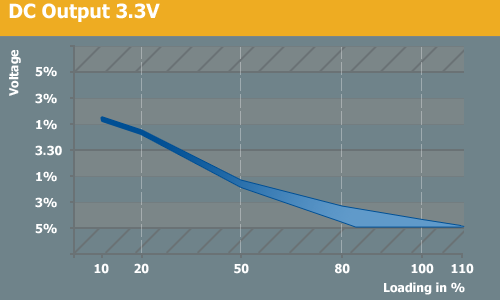
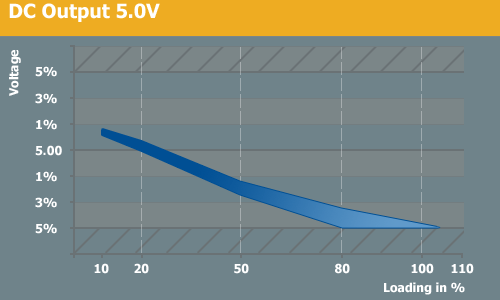
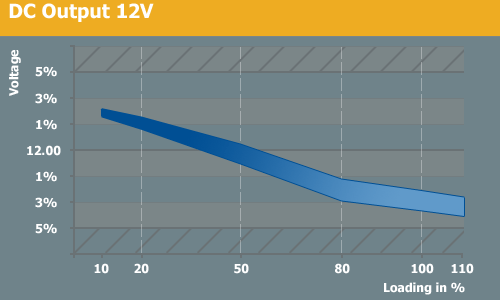
The two lower voltage rails perform okay, but at higher loads we came to the lower edge of the specified 5% deviance and even below with around 1000W of load. The 12V rail held stable in the range of 3% under the ideal amount of 12.00V. Since we show all six rails in only one graph it has a wide range of different distribution. While having the lower voltage rails drop out of spec is something of a problem, it's actually not as bad as some might think. Most of the load will be placed on the 12V rails, and as difficult as it will be to configure a system that can make use of 1250W of power, it is even more unlikely that most systems will come anywhere near requiring 100W on the 3.3V rail or 150W on the 5V rail - not to mention the 5Vsb rail. Still, it would be best to have all rails stay within spec.
Ripple & Noise Results
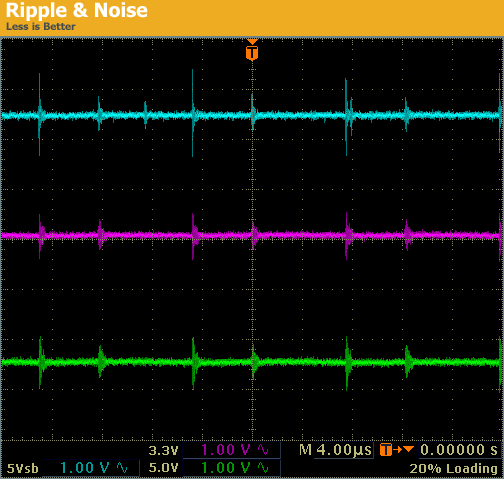
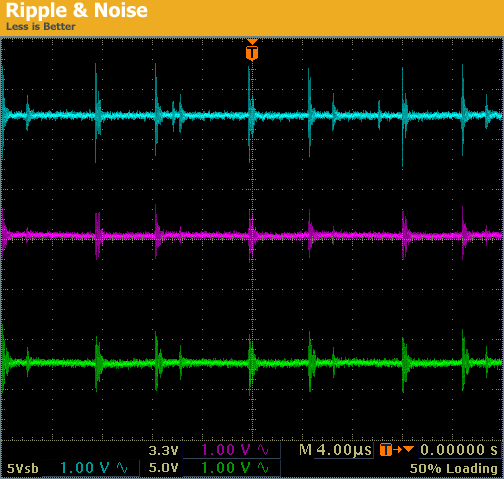
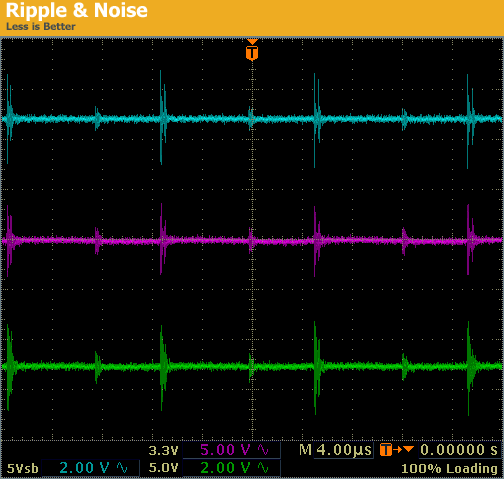
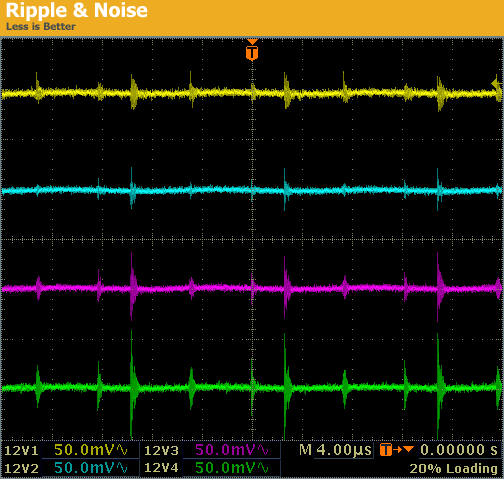

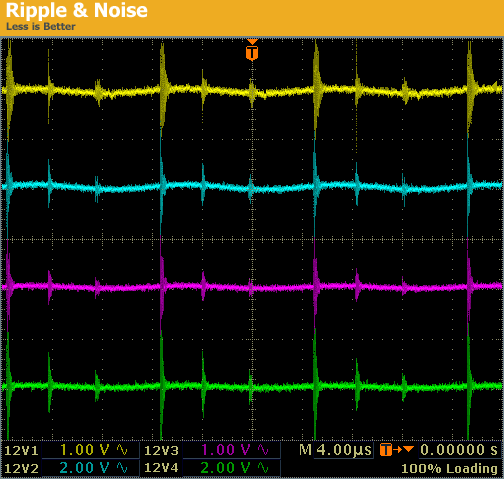
The Cooler Master power supply has more than just four 12V rails but to keep an acceptable overview we decited to just show four of them in each graphic.
| Cooler Master Real Power PRO 1250W Load Values | |||||||||
| PSU Load | 3.3V | 5V | 12V1 | 12V2 | 12V3 | 12V4 | 12V5 | 12V6 | Wattage All Rails |
| 10% | 2.68 | 2.68 | 1.16 | 1.16 | 1.62 | 1.62 | 1.62 | 1.16 | 127W |
| 20% | 5.36 | 5.36 | 2.32 | 2.32 | 3.24 | 3.24 | 3.24 | 2.32 | 252W |
| 50% | 13.4 | 13.4 | 5.79 | 5.79 | 8.11 | 8.11 | 8.11 | 5.79 | 621W |
| 80% | 21.44 | 21.44 | 9.27 | 9.27 | 12.97 | 12.97 | 12.97 | 9.27 | 979W |
| 100% | 26.8 | 26.8 | 11.58 | 11.58 | 16.22 | 16.22 | 16.22 | 11.58 | 1210W |
| 110% | 29.48 | 29.48 | 12.74 | 12.74 | 17.84 | 17.84 | 17.84 | 12.74 | 1322W |
DC Outputs



The two lower voltage rails perform okay, but at higher loads we came to the lower edge of the specified 5% deviance and even below with around 1000W of load. The 12V rail held stable in the range of 3% under the ideal amount of 12.00V. Since we show all six rails in only one graph it has a wide range of different distribution. While having the lower voltage rails drop out of spec is something of a problem, it's actually not as bad as some might think. Most of the load will be placed on the 12V rails, and as difficult as it will be to configure a system that can make use of 1250W of power, it is even more unlikely that most systems will come anywhere near requiring 100W on the 3.3V rail or 150W on the 5V rail - not to mention the 5Vsb rail. Still, it would be best to have all rails stay within spec.
Ripple & Noise Results






The Cooler Master power supply has more than just four 12V rails but to keep an acceptable overview we decited to just show four of them in each graphic.










27 Comments
View All Comments
redly1 - Monday, October 22, 2007 - link
I'm just trying to imagine the flames that ensue when something goes bad on the motherboard.Anyone ever burn up a classic Athlon by forgetting to put the heatsink on? Imagine doing that with a 1.3kW supply? Yikes
billa16 - Tuesday, October 23, 2007 - link
I did that on a k7@950. I was trying to oc it(hardmod with a pencil). Nothing happend the first 2 times(just a few secs). After that it's stopped working. No sparks/flames and stuff like that. Don't belive anything U read/see on the internet.This type of power supply's have protections. If something is damaged so bad that would cause flames the protection kicks in. The worst fire scenario with this type of PSU will be a flash when the fuse burns out.
Sorry for my poor english.
DigitalFreak - Monday, October 22, 2007 - link
Still amazes me how many people fall for the marketing hype...Traciatim - Monday, October 22, 2007 - link
Instead of just giving specs and doing an overview of the efficiency, why not design a machine that actually needs these over say a 600-700Watt PSU and show watt you would need to do do actually use one of these.I have a pretty small machine, and it regularly pulls 120Watts out of the wall, 200Watts if I Get everything ramped up. I'm also using a P4, not a Core2Duo so it's not going to be as efficient.
The ONLY point that I can see to have one of these is simply to waste money on uneeded equipment that could be better spent one something performance based and to say that 'My PSU is bigger than your PSU'.
retrospooty - Monday, October 22, 2007 - link
Ya, these 1000+ watt PSU's are marketed to enthusiests, and are supposed to be for heavily overclocked quad core CPU's (meaning cascade, dry ICE or liquid nitrogen cooling kind of overclocks) with overclocked high end SLI or crossfire rigs, and plenty of hard drives and other peripherals added as well. We are talking $3000 or higher systems - WAY overkill probably even for that purpose.JarredWalton - Monday, October 22, 2007 - link
You can see the most power-hungry system I've personally tested http://www.anandtech.com/systems/showdoc.aspx?i=30...">right here - which uses standard ATX components and a Topower PSU. That's a lot more system than most people run, obviously, but if maximum efficiency is achieved in the 40-80% load range, and if that particular PSU was around 80% efficient, it was outputting around 600W of power at maximum load.Toss in TriFire HD 2900 XT and you could add another 100W to that, maybe. If you were to get an overclocked Xeon platform with dual quad-core CPUs plus CrossFire/TriFire, you could actually reach the point where 1300W was "required". LOL
ORB chasers and "professional benchmarkers" running at insane overclocks (i.e. 5000 MHz quad-core) deal with exponential power requirement increases as well. The solution is either to use multiple PSUs or else get one of these uber-powerful designs. So these appear to be for around 0.01% of the market, I guess?
Michael91ah - Monday, October 22, 2007 - link
Glad to see the statistics for these 3 units. I really like the Cooler Master's curve on the acoustics. That noise makes a big difference for me when choosing a power supply.